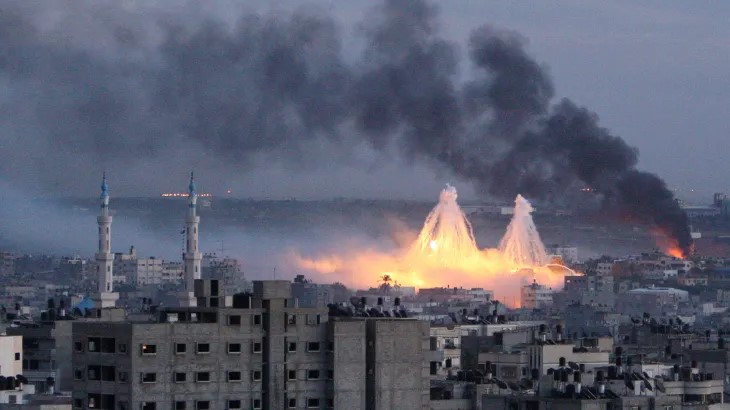Since the beginning of Israel’s aggression on the Gaza Strip its war machinery has not ceased to use various types of weapons and destructive projectiles with serious effects on the civilians and their residential areas thereby violating the principles of international humanitarian law.
A report issued by three Palestinian human rights institutions based on consistent testimonies confirmed the use of white phosphorus by the Israeli forces against residential areas in several neighborhoods. This was previously announced by the Ministry of Interior in Gaza and the government’s Media Office.
White phosphorus is a flammable chemical component that causes second and third-degree chemical burns upon contact with the skin. It poses a serious threat to the lives of civilians leading to severe injuries that may result in death when it comes into contact with the skin is inhaled or swallowed.
The human rights report stated that many injured suffered severe burns and lacerations some medical teams expressed fears about the use of white phosphorus projectiles by the Israeli forces along with new projectiles that have not been used before causing this type of severe burns and injuries.
Serious Effects
The report warned that the use of white phosphorus in densely populated civilian areas has extremely serious effects making its use a blatant violation of the principles of international humanitarian law such as taking into consideration the necessary precautions during military attacks which require the highest levels of caution and using appropriate means and methods to prevent civilian casualties.
How to respond when exposed to white phosphorus?
Given the repeated use of white phosphorus by Israel against Palestinian civilians the Palestinian Information Center highlights how to respond to exposure as reported by several sources including Al Jazeera.
According to the US Centers for Disease Control and Prevention initial supportive treatment is primarily recommended.
In cases of skin or eye exposure this includes immediate removal of burning white phosphorus particles from the victim’s eyes or skin.
In the case of skin or eye contamination with white phosphorus it is advised to cover them with a cool wet cloth to prevent re-ignition.
Here are the first aid methods for each case separately:
First Aid for Eye Exposure to White Phosphorus:
* Immediately remove the victim from the source of exposure.
* Evaluate respiratory and pulse function.
* Ensure that the victim has an unobstructed airway.
* If there is difficulty breathing or shortness of breath administer oxygen.
* If breathing stops provide artificial respiration.
* Monitor the victim for signs of systemic effects and administer symptomatic treatment as necessary.
* Seek immediate medical attention.
First Aid for Skin Exposure to White Phosphorus:
* Immediately remove the victim from the source of exposure.
* Submerge the affected skin areas in cold water or cover them with wet dressings at all times.
* Vigorous washing with cold water is the best method to remove white phosphorus from the skin.
* Remove visible particles of white phosphorus during washing with large amounts of cold water or by immersing the area in cold water.
* The use of cold water is crucial but caution must also be taken to protect the victim from hypothermia.
* Avoid using oily or greasy ointments that may increase the absorption of white phosphorus.
* Monitor the victim for signs of systemic effects.
* Seek immediate medical attention.
General Tips for Dealing with White Phosphorus Victims:
– Remove the patient from the exposure area.
– Carefully remove their clothing and personal belongings considering that contaminated clothing may catch fire or ignite again. Therefore contaminated items should be placed in a sealed container filled with water and clearly labeled as hazardous materials.
– Rinse and wash the skin with cold water and keep exposed areas moist.
– If the eyes are exposed to white phosphorus or the smoke resulting from its use the eyes should be washed first with a large amount of water or a 0.9% saline solution for 10-15 minutes (removing contact lenses if this can be done easily) and the use of a local anesthetic will reduce eyelid spasm and facilitate washing. However washing should not be delayed if the anesthetic is not available.
– If there are particles of phosphorus in the eye the eyelids should be everted and the particles should be removed while continuing to wash. The removed particles should be placed in a container with water and a thorough examination of both eyes should be conducted with urgent referral to an ophthalmologist if there is evidence of injury.















